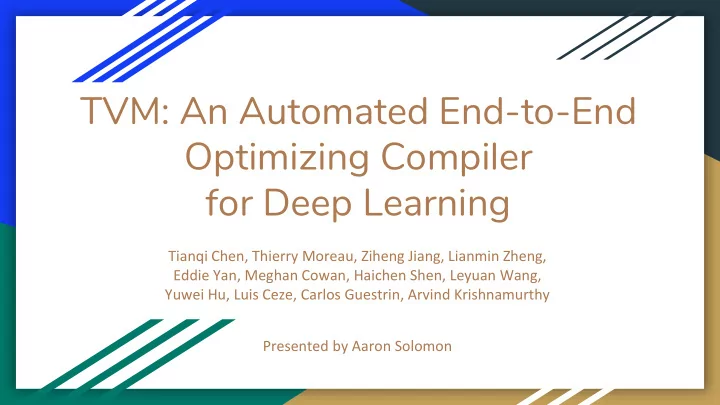

TVM: An Automated End-to-End Optimizing Compiler for Deep Learning Tianqi Chen, Thierry Moreau, Ziheng Jiang, Lianmin Zheng, Eddie Yan, Meghan Cowan, Haichen Shen, Leyuan Wang, Yuwei Hu, Luis Ceze, Carlos Guestrin, Arvind Krishnamurthy Presented by Aaron Solomon
Deep Learning - everywhere! Old School: Today: CPU CPU GPU TPU
Fundamentally different memory architectures
Challenges for Generalized Deep Learning ● Numerous hardware devices ○ GPUs, CPUs, TPUs, etc ● Bespoke low-level implementation needed to maximize efficiency on each ASIC/chip ● Many DL software solutions ○ Keras, TensorFlow, PyTorch, etc ● Lots of tuning ● Manual optimization is time intensive
Current Optimization ● Keras But graph ● TensorFlow optimization does not ● MXNet help low-level ● Caffe hardware efficiency! Current architectures may perform high-level graph optimization and bespoke kernels
TVM ● Current SOA: ○ Each DL package implements bespoke code for kernels ○ High-level graph optim ● Goal: automate generation of optimized low-level code for many backends without human intervention by providing high-level (graph) and low-level optimizations ● Contributions ○ Graph Rewriter ○ Tensor Expression Language ○ Automated Program Optimization ○ Overall: automates time intensive process
TVM
Graph Level Modifications ● Operator Fusion ○ Combines many small ops ● Constant Folding ○ Pre-computes static graphs ● Static Memory Planning Pass ○ Pre-allocates memory for needed tensors ● Data Layout Transformations ○ Optimize data storage for each backend
Operator Fusion ● Operator Types ○ One to one (addition) ○ Reduction (sum) ○ Complex-Out-Fusable (fuse element-wise) ○ Opaque (not-fusable) ● Specify rules for combining operators ● Avoids intermediate memory storage
Data Layout Transforms ● Many possible storage options ○ What does the kernel use? 4 x 4 matrix or length 16 vector? ● Considers hardware-preferred data layout and optimizes if possible ● Transforms data between producer and consumer if unequivalent TPU CPU Transforms if needed
Tensor Expression Language ● Specify products and operation, let TVM decide how to accomplish it ● Many schedules proposed, inefficient ones culled
Nested Parallelism and Tensorization ● Nested Parallelism ○ Explicit memory scopes enable multiple threads to share the same reference memory ○ Reduces fetch and mem transfer time ● Tensorization (compute primitives for tensors) ○ Uses specific language ○ Extensible - just specify hardware and the data representation it wants
Latency Hiding ● Simultaneous memory and compute ops to maximize efficiency ● CPUs ○ Multithreading ● GPUs ○ Context switching ● TPUs ○ Decoupled access/execute ● Virtual threading to control latency hiding
Automated Program Optimization ● So many pieces of code and scheduling primitives! ● Adversarial System ○ Part 1: Proposes new schedule configuration ○ Part 2: Predicts cost of proposed configuration
Automated Program Optimization ● Schedule Template Specification ○ Schedule = possible configuration ● One Hot Encoding of program features (loop elements, etc) ● Cost Model ● Simulated Annealing, Random Walks ● Gradient Tree Boosting ○ Input: Low Level Code ○ Output: Estimated (relative) time
Operator Fusion
Mem Loading
Speed Up
Conv Net Results
TVM MultiThread Capability
Mobile
VDLA/FPGA
Critique ● Good performance relative to baseline ● Not clear how much is actually novel ○ Other autotuners exist (ATLAS, FFTW, OpenTuner) ○ “Larger search space” ● Lack comparisons that actually demonstrate device generalizability that they seek ○ Should show TVM optimized systems vs. optimized package specific ● Automated work is sparse ○ Presented as “optimization with a side of automation” rather than an automation paper
Thank You!
Recommend
More recommend